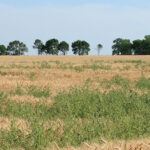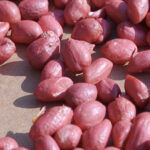Effective Defense Strategies Help Protect Crops Against Corn Rootworm
Collecting intel on corn rootworm is critical to outwit this sly and destructive pest.

- Corn rootworm (CRW) beetles concentrate in late-planted or replanted acres.
- Later-maturity corn increases good habitat time for CRW.
- Rotate from continuous corn production in high-pressure CRW areas.
“If it ain’t broke, don’t fix it.” Unfortunately, that’s the wrong strategy when facing corn rootworm (CRW). The pest is adaptive and destructive. Now more than ever, monitoring and maneuvering are essential defense strategies.
“Corn rootworm is our No. 1 economic pest. When it’s bad, it’s really bad,” says Erin Hodgson, Ph.D., Iowa State University extension entomologist.
Andrew Nesseth, crop consultant with EXTended Ag Services of Lakefield, Minnesota, says CRW pressure and crop damage is increasing in his area as mild winters and more continuous corn acres create ideal conditions. Dry weather also amplifies yield losses, as damaged roots are less likely to regenerate, leaving fewer roots to take up moisture.
As frustrating as losses can be, Hodgson urges restraint in management. “We do not recommend the ‘kitchen sink’ approach,” she says. “Corn rootworm is a very adaptable pest. If you use every tool all the time, a small population will adapt and overcome.”
Instead, she says, growers should assess CRW pressure and build a strategic battle plan.
Assess the Enemy
The most significant damage from CRW occurs when larvae feed on brace roots in June and July. This is when to start scouting for the pest.
“It’s most accurate to dig corn and look for root injury, but it’s a time-consuming and miserable task in July,” Hodgson says, noting that using sticky traps to capture CRW adults is an easier and still effective option for scouting.
Most problematic situations occur when the same management practice is used year after year. Changing things up keeps the options we have working better for longer.
If growers catch two or more beetles per card per day, it indicates pressure will exceed economic thresholds. Some CRW eggs undergo extended diapause, which is a period of suspended development. However, in areas of the Eastern Corn Belt where a variant exists that will lay eggs in soybeans, growers should also consider scouting soybean fields.
“It doesn’t take many larvae to reduce yields by 30 to 40%,” Hodgson says. “Beyond root damage, feeding opens roots to pathogens and other pests. It’s death by 1,000 papercuts.”
Build a Battle Plan
“Most problematic situations occur when the same management practice is used year after year,” says Bruce Battles, Syngenta technical agronomy manager. “Changing things up keeps the options we have working better for longer.”
Some options to mix and match based on crop history, planting date and expected and historical pest pressure include:
- Low pressure: Use a non-CRW traited hybrid with or without a soil insecticide.
- High pressure: Use a soil insecticide along with a single CRW trait, multiple CRW traits or a non-CRW traited hybrid.
- Very high pressure: Rotate to a non-host crop for one or more years.
Traits are the baseline for most growers battling CRW, says Tim O’Brien, Syngenta traits manager. They provide easy, season-long CRW protection. And with stacked traits, growers can use one product to control multiple insects. One option is DuracadeViptera™ trait stack, which protects against 16 above- and below-ground pests.
But traits alone can’t hold the line in very high pressure CRW fields; A four- to five-year rotating strategy is a better option, Battles says. It might look like this: Following soybeans plant a non-CRW traited hybrid. Next season, use a CRW-traited hybrid and monitor CRW pressure. Depending on pressure, use a CRW-traited hybrid again the next year, but rotate or combine modes of action. If CRW pressure increases, use CRW-traited hybrids with soil-applied insecticides. In cases of particularly strong pressure, an in-season insecticide application to reduce adult CRW populations may provide some relief.
Seed treatment can provide more protection, but isn’t a stand-alone alternative, Battles says. CruiserMaxx® Corn 1250 seed treatment is one effective option. It increases seedling vigor to help overcome root injury and provides short-term systemic protection for early roots. The CRW node injury scale is zero to three nodes, with one node being above economic thresholds. Battles says CruiserMaxx Corn 1250 can reduce damage by 0.25 nodes.
Identify Future Risk
Past and current field management are good indicators of future CRW populations. Scouting for root damage and tracking adult beetle populations are good predictors of expected CRW populations next season. Each corn rootworm adult female can lay 1,500 to 2,000 eggs. When those eggs hatch the following season, their larvae begin to feed on corn roots. When using traits, the larvae must take a bite for the trait to provide control. “If everyone comes to the table for a little nibble, that’s a lot of potential damage,” Battles says.
Planting date is also an important consideration, as CRW beetles tend to concentrate in fresh habitat, Nesseth says.
“They go to the youngest corn,” he says. “Beetles will concentrate in areas with late-planted hybrids or replanted acres.”
Longer-season corn can lead to greater problems, too. “It increases the length of time there’s good habitat for corn rootworm beetles. It’s a complex problem,” Nesseth says.
Rotating to a non-host crop like soybeans is the best way to derail increasingly heavy CRW populations. When scouting shows very high pressure, it’s time to rotate from continuous corn, O’Brien says.
“It is difficult for any CRW technologies to stand up to extreme, high-pressure situations,” he says. “We must rotate to maximize yield potential and protect the CRW management tools we have.”























